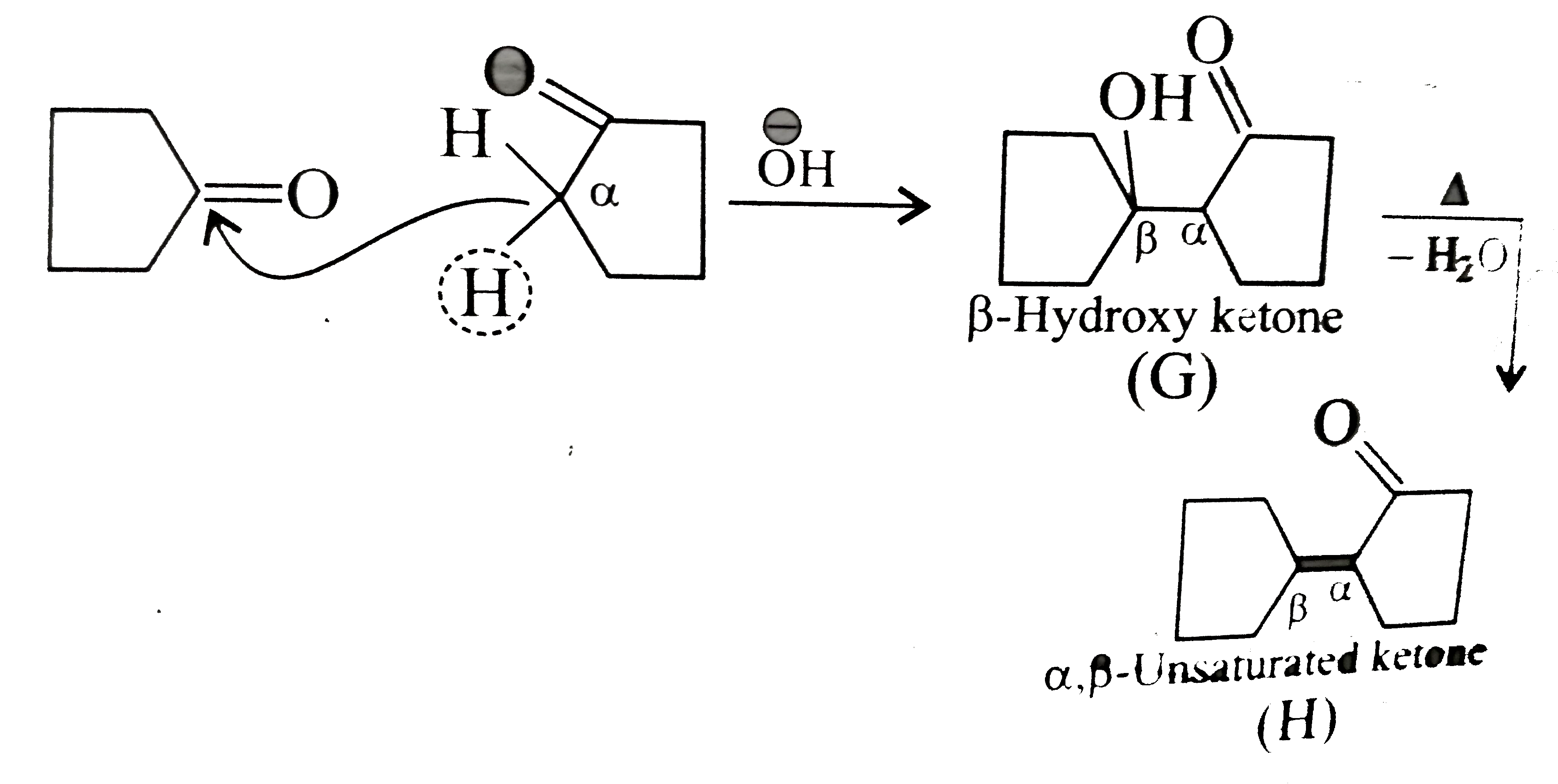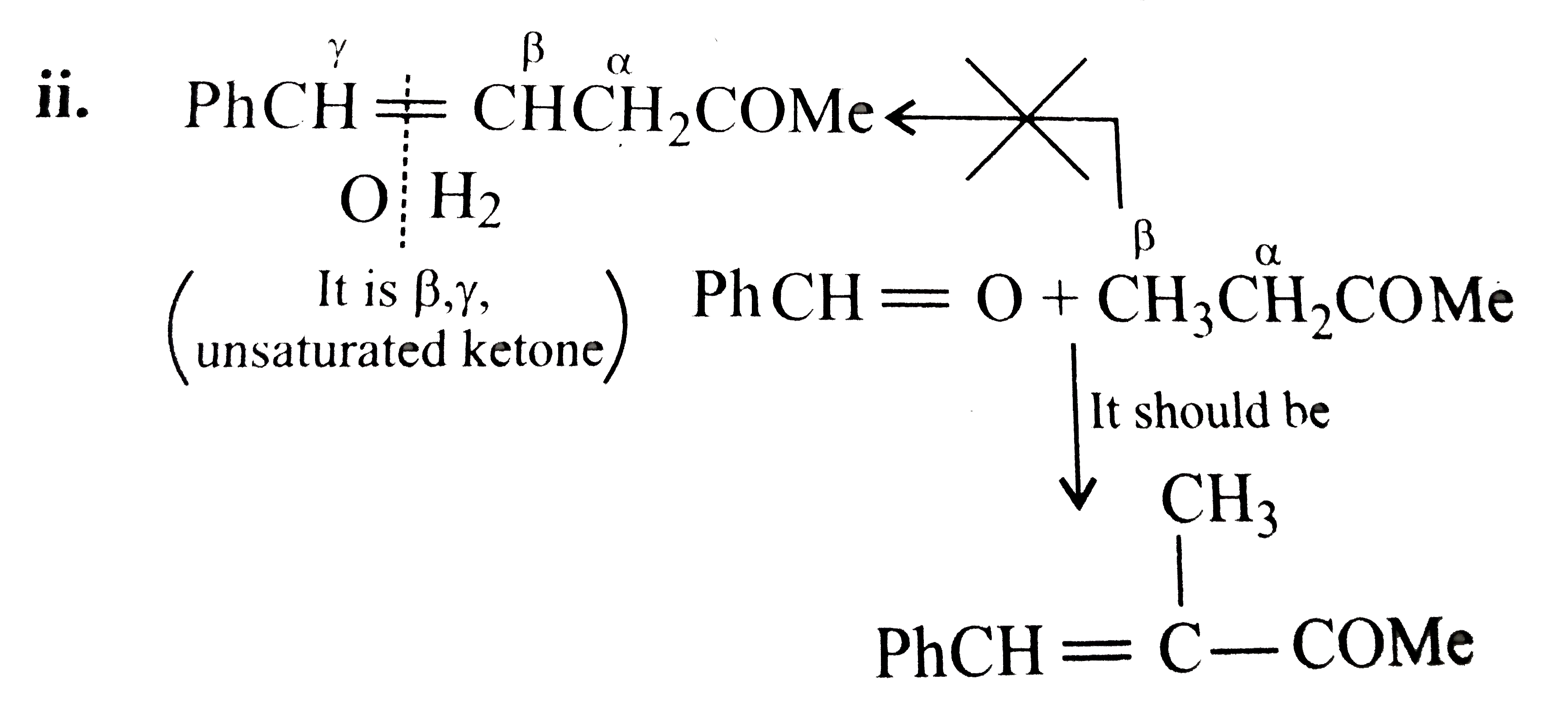1. i. 2CH3CH2CHOΘOH−−→(A)Δ−−→(B)
ii. 2PhCH2CHOΘOH−−→(C)Δ−−→(d)
iii. ![1. i. 2CH(3)CH(2)CHOoverset(Θ)overset(OH)rarr(A)oversetDeltararr(B) ii. 2PhCH(2)CHOoverset(Θ)overset(OH)rarr(C)oversetDeltararr(d) iii. iv. 2. i. ii. A hydrocarbon (A) of the formula C(7)H(12) on ozonolysis gives a compound (B) which undergoes aldol condensation giving 1-acetyI cyclopentene. Identify (A) and (B). 3. Acetone and butan-2-one undergo both self and across aldol (ketol) condensations to gove aldol (ketol) which loses water to give alpha,beta- unsaturated ketones. The number of isomeric alpha,beta- unsaturated ketones formed is: i. Three iii. Four ii. Five iv. Six 4. Give the cyclic intramolecular aldol condensation of the following reactions: a. Hexane-2,5-dione underset((ii) Delta)overset((i)overset(Θ)(O)H)rarr b. Octane-2,8-dione underset((ii) Delta)overset((i)overset(Θ)(O)H)rarr c. Nonane-2,8-dione underset((ii) Delta)overset((i)overset(Θ)(O)H)rarr d. Pentane-2,4-dione underset((ii) Delta)overset((i)overset(Θ)(O)H)rarr 5. Identify the reactants that can be and that cannot be synthesised from the compounds given below. i. PhCH=CHCOCH=CHPh ii. PhCH=CHCH(2)COMe iii. PhCH=CHCH(2)CH(2)COMe iv. PhCOCH=CH(2) v. PhCH=CHCH=CHCOMe vi. 3- Ethyl -2- methyl cyclohex -2-en-one vii. 2- Methyl cyclohex -1-ene-carboxaldehyde viii. ix. 1- Hydroxy-4-methyl bicyclo [2.2.2] octan-3-one 6. Give the mixed aldol product from the reaction of crotonaldehyde (CH(3)CH=CH-CH=O) with CH(3)CHO](https://d10lpgp6xz60nq.cloudfront.net/physics_images/KSV_CHM_ORG_P2_C13_S01_014_Q01.png)
iv. 
2. i. 
ii. A hydrocarbon (A) of the formula C7H12 on ozonolysis gives a compound (B) which undergoes aldol condensation giving 1−acetyI cyclopentene. Identify (A) and (B).
3. Acetone and butan−2-one undergo both self and across aldol (ketol) condensations to gove aldol (ketol) which loses water to give α,β− unsaturated ketones. The number of isomeric α,β− unsaturated ketones formed is:
i. Three
iii. Four
ii. Five
iv. Six
4. Give the cyclic intramolecular aldol condensation of the following reactions:
a. Hexane−2,5−dione (i)ΘOH−−−−→(ii)Δ
b. Octane−2,8−dione (i)ΘOH−−−−→(ii)Δ
c. Nonane−2,8−dione (i)ΘOH−−−−→(ii)Δ
d. Pentane−2,4−dione (i)ΘOH−−−−→(ii)Δ
5. Identify the reactants that can be and that cannot be synthesised from the compounds given below.
i. PhCH=CHCOCH=CHPh
ii. PhCH=CHCH2COMe
iii. PhCH=CHCH2CH2COMe
iv. PhCOCH=CH2
v. PhCH=CHCH=CHCOMe
vi. 3− Ethyl −2− methyl cyclohex −2−en-one
vii. 2− Methyl cyclohex −1−ene-carboxaldehyde
viii. 
ix. 1− Hydroxy−4−methyl bicyclo [2.2.2] octan−3−one
6. Give the mixed aldol product from the reaction of crotonaldehyde (CH3CH=CH−CH=O) with CH3CHO
Text Solution
1. i. 
ii. 
iii. 
iv.
2. i. 
ii. 2 D.U. in A=(2nC+2)−nH2=16−122=2∘
Two D.U. in (A) suggest one (C=C) bond, cyclic compound obtained with base suggests ring in (A).

Proceed reverse:

3.d.
Three self and three crossed aldol condensation products: Butan−2-one (unsymmetrical ketone) has two types of dissimilar α−H atoms (αMeCOCα'H2Me), and acetone (symmetrical ketone) has only one type of similar α−H atoms (αMeCOαMe).
4 a. 
b. 
c.

d. (CH3−CO−CH2−CO−CH3) merely forms the stable carbanion ⎛⎝CH3−CO−C..ΘH−COCH3⎞⎠ and does not react further. Carbanion does not add to C−4 because a strained four-membered ring be would be formed.

5. i.
iv. 
v. 
If the adol reaction of PhCH=O (I) with
CH3CH=CH−O∣∣C−Me(II) occurs, two different carbanions (enolate anions) can form
..ΘCHγ2CHβ=CHα−O∣∣C−Me(III) and
CH3CH=CH−O∣∣C−ΘCH2(α) (IV).
The carbanion (enolate anion) (III) is formed more easily than (IV). The carbanion (III) formed by the removal of γ−H of (II) with base is delocalised to O through the conjugated system giving carbanion enolate.

This anion (III) adds to the (C=O) of PhCH=O(I) to give δ-hydroxy alcohol which rapidly loses H2O to give the product that is triply conjugated and also is extended-conjugated with Ph group.

vi. 
vii. 
ix. 
The reactants of the products that cannot be synthesised by aldol condensation: (ii), (iii), and (vii).
ii. 
iii. 
vii. 
6. 
|
Topper's Solved these Questions
- ALIPHATIC AND AROMATIC ALDEHYDES AND KETONESBOOK - CENGAGE CHEMISTRY ENGLISHCHAPTER - ALIPHATIC AND AROMATIC ALDEHYDES AND KETONESEXERCISE - Solved Examples
13 Videos
- ALIPHATIC AND AROMATIC ALDEHYDES AND KETONESBOOK - CENGAGE CHEMISTRY ENGLISHCHAPTER - ALIPHATIC AND AROMATIC ALDEHYDES AND KETONESEXERCISE - Exercises Subjective
52 Videos
- ALCOHOL,PHENOL AND ETHERSBOOK - CENGAGE CHEMISTRY ENGLISHCHAPTER - ALCOHOL,PHENOL AND ETHERSEXERCISE - Archives Analytical And Descriptive
15 Videos
- APPENDIX INORGANIC VOLUME 2BOOK - CENGAGE CHEMISTRY ENGLISHCHAPTER - APPENDIX INORGANIC VOLUME 2EXERCISE - Short Answer Type
179 Videos
Similar Questions
A hydrocarbon (A) of the formula C7H12 on ozonolysis gives a compound (B) which undergo aldol condensation giving 1-acetylcyclopentene. Identify (A) and (B).
View SolutionA hydrocarbon (A) of the formula , C7H12 on ozonolysis gives a compound (B) which undergoes aldol condensation giving 1-acetylcyclopentene. Identify (A) and (B).
View Solution
Knowledge Check
Butanal undergoes aldol condensation to give
ACH3CH2CH2C∣OHHCH2CH2CH2CHOBCH3CH2CH2C∣OHHC∣OHHCH2CHOCCH3CH2CH2C∣OHHC∣CH2−CH3HCHODCH3CH2CH2C∣OHHC∣OHHCH2CH2CH3Acetone undergoing Aldol condensation followed by dehydration gives
A4-Methylpent-3-ene-2-oneB4-Methylpent-2-ene-2-oneCBut-2-enalD2,3-Dimethylpentan-2-oneIdentify the following disproportionation reaction.
I. 2H−D∣C=O+ΘOH→Acid salt (A) + alcohol (B)
II. 2D−D∣C=O+ΘOH→Acid salt(C)+alcohol (D)A(A)(B)(C)(D)D−O∣∣C−OΘCH2DOHD−O∣∣C−OΘCH2DOHB(A)(B)(C)(D)H−O∣∣C−OΘCH3OHH−O∣∣C−OΘCH2DOHC(A)(B)(C)(D)H−O∣∣C−OΘCH2DOHD−O∣∣C−OΘCH2DOHD(A)(B)(C)(D)D−O∣∣C−OΘCH2DOHD−O∣∣C−OΘCD3OH
(B)ΘOH←CH2=CH−CHOAI(OEt)3−−−−−−→(A)
View Solution(B)ΘOH←CH2=CH−CHOAI(OEt)3−−−−−−→(A)
View SolutionCH3CHONH2−NH2−−−−−−→[A]KOH−−→[B]Br2/hv−−−−→[C]KOH(alc)−−−−−→[D]
Identify D
View SolutionNumber of possible intra molecular aldol condensation product on heating with NaOH
H3C−O∣∣C−CH2−CH2−CH2−O∣∣C−H
View SolutionNumber of possible intra molecular aldol condensation product on heating with NaOH
H3C−O∣∣C−CH2−CH2−CH2−O∣∣C−H
View Solution
